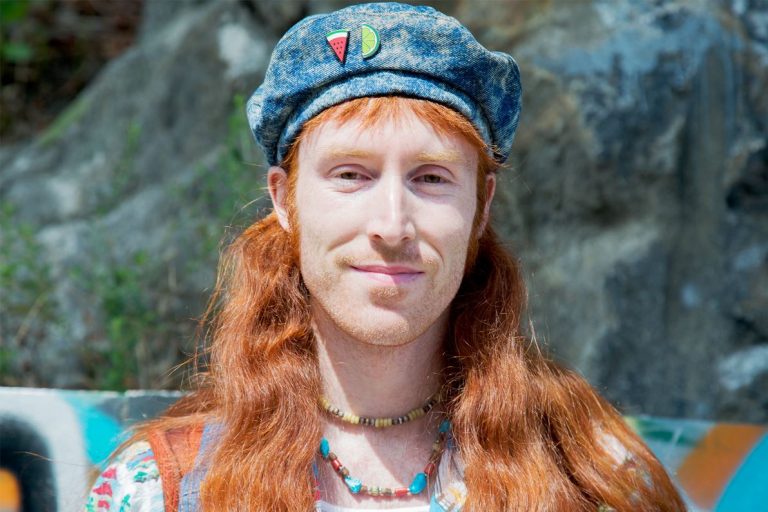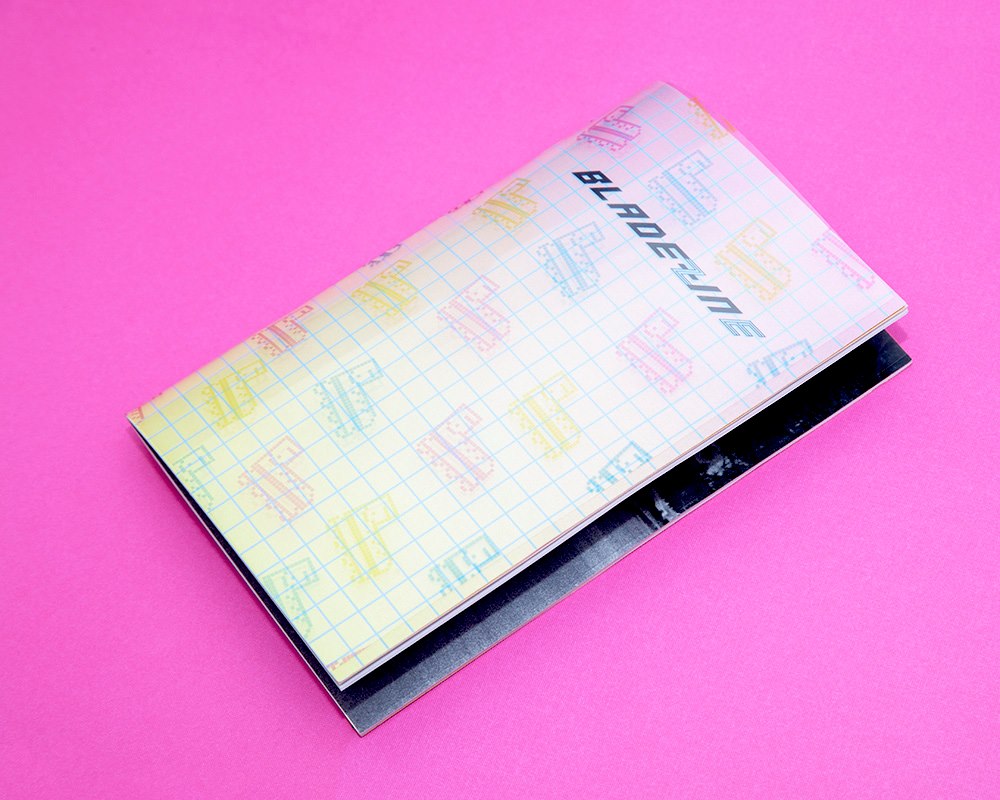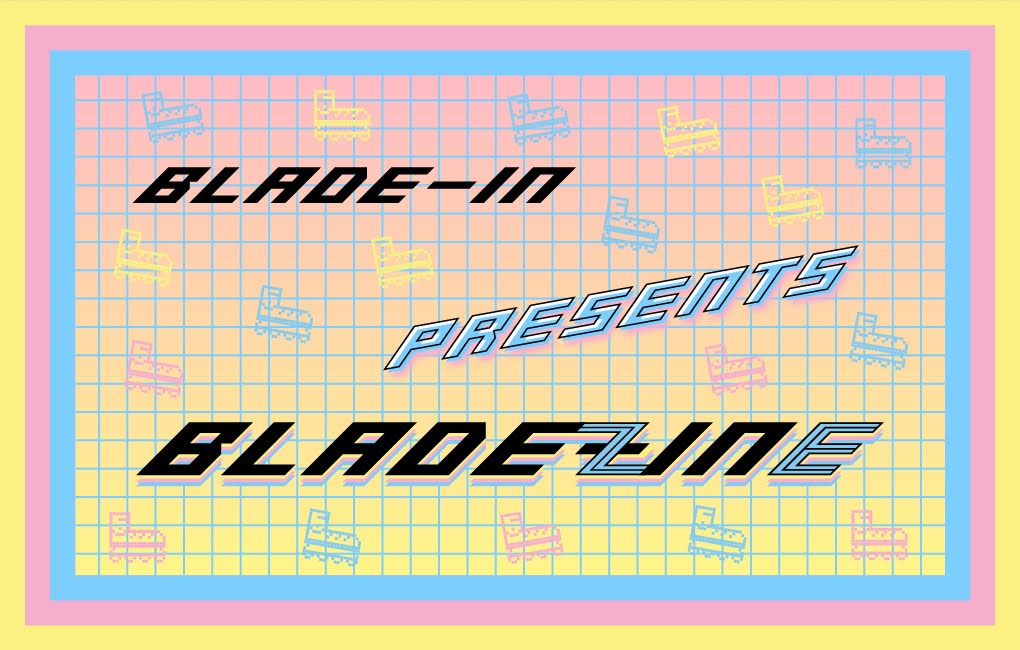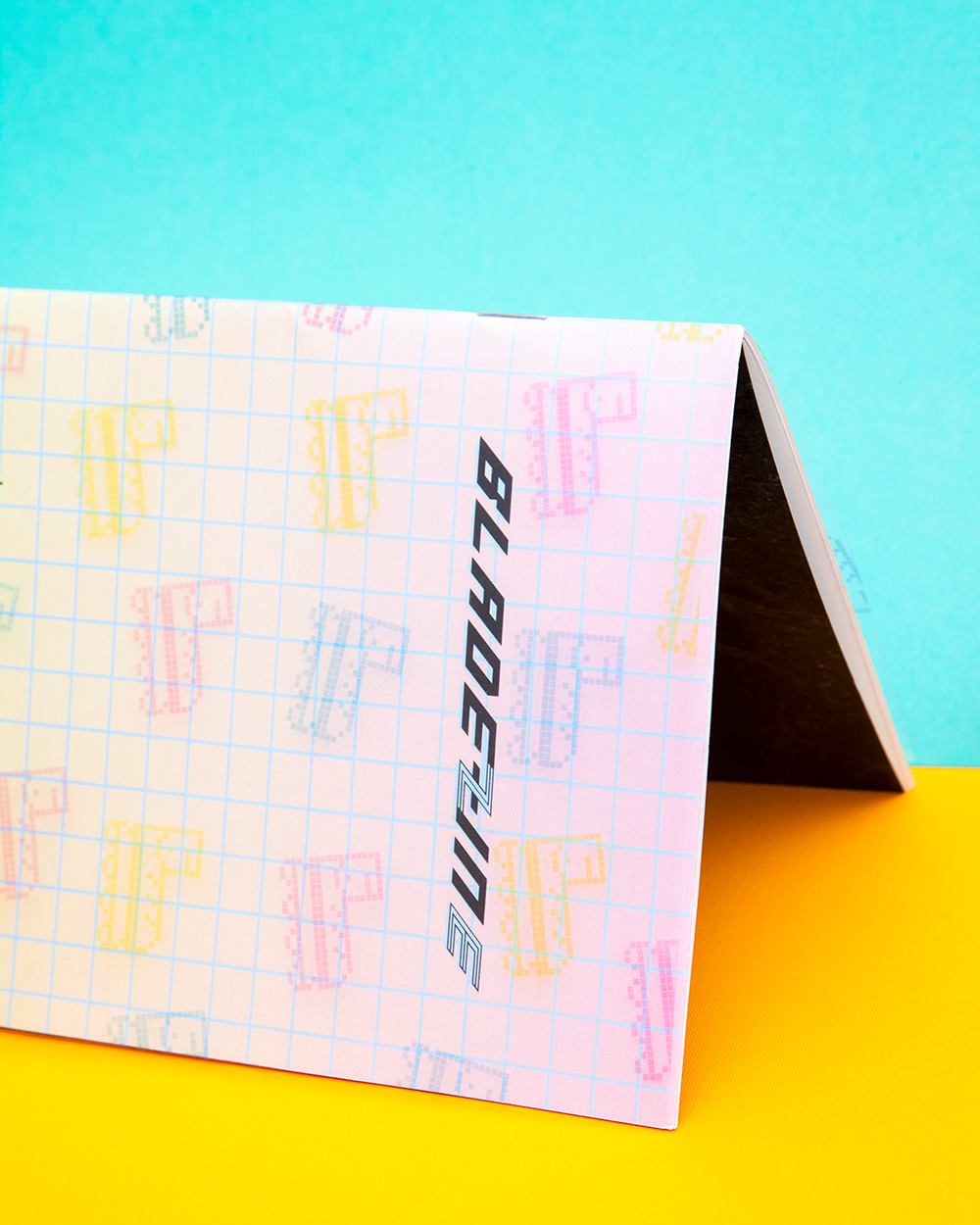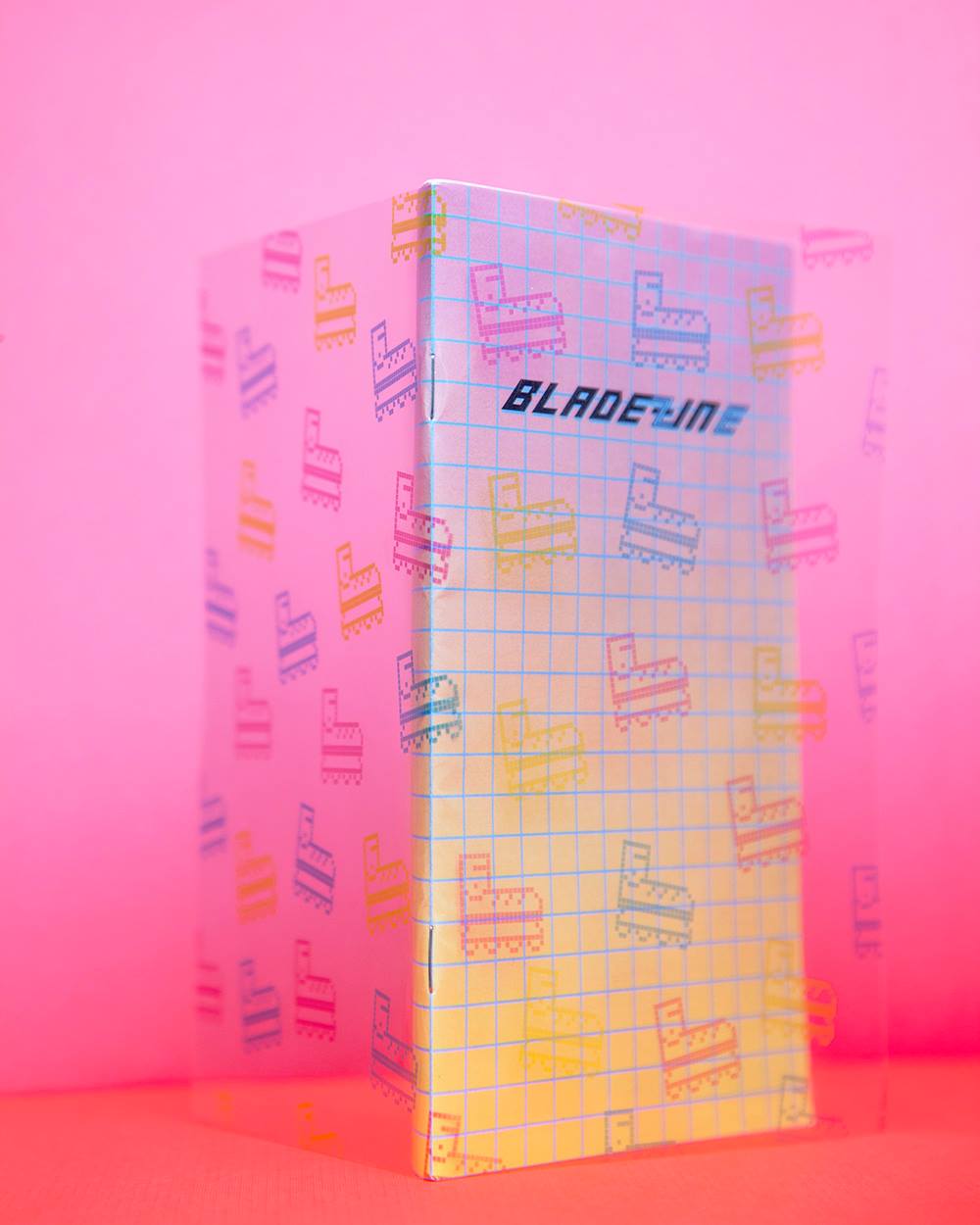Getting this interview done took a lot longer than we hoped. However, it is now that we can present you with Robbie Pitts‘ insights and motives in creating Bladezine and Blade-in. Dive in.
Intro: Josip Jagić
Interview: Ryan Loewy and Josip Jagić
Images: Ryan Loewy and Robbie Pitts
Where did the idea of Blade-In stem from? I know you have a background in graphic design of some sort, and just finished with university. Was this something that you had intended on doing for a while or is this something that relatively come to mind recently?
Firstly I’d like to clarify for the readers that BLADE-IN is a larger entity that consists of various sub-projects—one of those being BLADEZINE. The first BLADE-IN project was an event series called BLADE-IN CINEMA, during which I hosted evenings which showcased curated selections of rollerblading films. It originally was held at Long Play—a local cocktail bar in Melbourne, Australia which housed an open-to-community cinema space. After moving to the USA in April of last year I felt that it was the most appropriate time in my life to embark on the project—particularly as I had graduated from University and was now uninhibited by my former academic commitments. Living in Los Angeles and being constantly reminded of the rollerblading history that exists in the city, also really motivated me to invest my time into making BLADEZINE a reality. I always had the dream of producing my own rollerblading publication as I idolised all of the blading media of the late 90’s and early 00’s. Daily Bread, Be-Mag and Rejects were all operational during my formative times and were the prime influence in my developing interest in Graphic Design, Photography and Filmmaking. Upon graduating with an Undergraduate Degree in Visual Communication, I felt a sense of confidence in my design abilities, which made the move to develop BLADEZINE more so natural. The whole endeavour became a matter of reaching out to my friends and the people who’s work on and off the blades had inspired me. This began the process of what became 000 ISSUE. I am eternally grateful for all of the enthusiasm the contributors expressed to me when I approached them about the project. Their responses really inspired me to actualise this idea that I had had for many years.
Who was involved in the production of the first issue?
000 ISSUE is indebted to the following people for their wonderful contributions: Adam Kola, Anthony Zinonos, Sam Currie, Dom West, Spencer Eckl, Malcolm Heard, Ryan Gillett, Simon Isles, Erick Garcia, Scott Blackmore, Harry Abel, Felix Strosetzki, Jarrod Thackeray, Tim Wolff, Colin Brattey, Dominik Wagner, David Grant, Michael Decker and Sean Brian McDonald. Each of these individuals helped 000 ISSUE by contributing photographs, artwork, graphics, and advertisements for their respective films and/or companies. If not for their belief and support in the prospect of the project, BLADEZINE would not have been realised—particularly in the diverse multinational way it did.
I understand that you handled the majority of the art direction. Where did you find the inspiration for the design of this?
The Art Direction for BLADEZINE had already been relatively established, for the foundation of the identity was formulated during the creation of BLADE-IN CINEMA. Once the pre-production side of 000 ISSUE commenced, I translated those established graphic elements to suit the format and requirements of the print publication. The inspiration for the aesthetic came out of Late 1970’s video-games. I saw parallels between the history of video-games and that of inline skating in that video-games also experienced a dramatic decline post a period of popularity and prosperity. I have a number of friends who are really into the video-gaming world—particularly in relation to Super Smash Bros.—and through our conversations it became clear to me that there were similarities between the two cultures. Gamers’ enthusiasm towards their activity and culture; and the connectedness felt towards one another, seemed to mirror the kind of unspoken bond rollerbladers often describe experiencing. I also felt that to the general public, rollerblading could now be considered a “retro” activity, and the utilisation of retro aesthetics would be rather appropriate. Combining this with a modern colour platte and experimental production processes, I aimed to create an aesthetic which had its visual roots in the past whilst equally existing as a product of its time. For this too is indicative of the modern image of rollerblading—familiar yet far more evolved and sophisticated than the common depiction. Whilst being a refined and considered aesthetic, I wanted a sense of vibrance to the art direction, so that all-in-all it was a reflection of fun—and much like blading, it should not be needing for itself to be taken too seriously.
I see that you’ve combined a variety of writings juxtaposed with a variety of imagery, do you have a specific model or format that you intend on following throughout the production of this, or do you intend to change things up?
BLADE-IN aims to embody fun and spontaneity so I intend to leave the structure of BLADEZINE open and flexible for each issue. I want to have as much freedom to experiment, therefore implementing a format or strict style guide would be counterintuitive. Having the flexibility to utilise a variety of materials and methods of production keeps the project fun and exciting for me. I like to think that by employing this process, it will allow for me to create a publication which will be recognisable as a series due to its overall thematic consistency but intrinsically standalone with each issue.
From an editor’s perspective, what do you look for in either a piece of writing or photography that you feel would deem it worthy of printing?
BLADEZINE is invested in showcasing the broad spectrum of rollerblading behaviour, where qualities may even extend beyond the realm of “tricks”, and emphasize the cultural and personal aspects of the individual and/or the collective community. The reason I am interested in showcasing these qualities is because I firmly believe there is generally far more to being a rollerblader than just having skates under your feet.
The model of a print magazine is very rarely explored these days due to cost and the overwhelming feed of new content from the intent. How has the reaction been to this?
Personally I’ve found that people have been really receptive—it has been truly wonderful. The overwhelming level of positivity inspires me for I believe it is an indication that there is still a desire for physical media in the blade world. Ultimately one cannot replicate the experience of viewing a physical magazine via digital means for its physicality and tactility are lost in translation. At the very least, this is enough motivation for me to validate the existence of BLADEZINE and perhaps here lies one of several potential reasons as to why people are drawn to the project.
I know you printed in a limited number. Is this something you intend to continue?
There will always be a limit to any product that is being reproduced by hand. Unfortunately in the case of BLADEZINE those numbers have to be far smaller due to the nature of the production process I implement. I thoroughly enjoy the process of producing books hands-on even whilst at times it can be arduous with time itself becoming an issue. Therefore I like to keep the edition at a reasonable number so that I am able to produce the publication within a sufficient timeframe. This hands-on process is important to me, for it is the physical transference and embodiment of my love and willingness to contribute to a community, which has formed the vast portion of my identity as a human being.
Hypothetically, do you feel providing something in a limited quantity may increase its demand?
Restricted Supply is a marketing strategy which is implemented a lot in business, so this could potentially work in the favour of anyone who decides to utilise it. As I described before, BLADEZINE employs a hands-on process which has a direct effect on the number of copies I am able to produce. Limiting quantities is therefore not necessarily a conscious choice but more a defaulted result due to the nature of production, which subsequently means each copy produced is unique from the next. Whilst I am methodical and perfectionistic in my process, due to the very fact that I collate, stick, trim, cut and assemble all of the elements together myself, means there are going to be minor inconsistencies and imperfections to the product. I hope people see this as a characteristic to embrace, as BLADEZINE is not a product of a mass-consumption—rather the embodiment of its counter.
How do you pick which skaters to feature?
000 ISSUE was curated less by a premeditated selection of skaters and more by reaching out to a number of likeminded individuals who I believed embodied a similar sense of passion and spirit towards rollerblading. I care not for exclusivity or pretension and my aim was to showcase a multinational and diverse representation of contemporary rollerblading. All of the skaters who featured in 000 ISSUE are talented and passionate individuals who, in my opinion, are great ambassadors for the activity and culture of rollerblading. However with that being said, I place as much of an importance and focus on the photographer and/or artist as the skater and their skating. With specific regards to photography, both should coalesce to form a captivating image that is expressive and visually interesting. Like us all as humans, I believe that every skater is unique and given so, each has the potential to express something distinctly their own through their actions on skates. Unlike any other time in our past, I believe there is an unparalleled level of diversity currently existing within our culture. BLADE-IN is invested in showcasing these talented individuals who’s work on and off; in front and/or behind the lens, signify the beauty and aesthetic variance of what can be done with pair of inline skates.
do you think it’s hard to avoid making media where you only actually feature your friends and people who share the same skating style?
I would say that for the most part it is natural to involve your friends for likemindedness is the basis of a lot of relationships in life. As human beings it could be said that we are drawn to interact and develop dialogue between those who share likeness to ourselves. This occurs in many different areas of one’s personal and working lives, and I believe that it is no different for the rollerblading community. Nepotism is ever so common in many creative disciplines but in no way would I say that BLADEZINE is guilty of such, as my guiding philosophy was to unite individuals to create a sense of community behind the platform. BLADEZINE is ultimately curated by myself but without the willingness and passion of the contributors, the project would not exist. My hope is that the project may inspire a discourse between myself and others who are passionate about rollerblading, which may eventually lead to collaborative relationships.
How do you feel about the fact that the lack of media in return results in skaters not really being perceived as personalities, but as just trick automatons, with no other substance?
I think media aids in creating a 3-dimensional image of a skater’s personality and overall identity—however it is still is a construct and therefore remains representational. I personally enjoy when I get the opportunity to meet and befriend rollerbladers first-hand. Interacting with someone in the physical world, allows for me to identify and relate to that person’s skating on an emotional level as opposed to a circumstantially objective one. Therefore media is definitely important as it helps broaden our perspective on one’s skating however I do really think it all depends on the blader themselves. Some people have more extroverted personalities so they naturally shine through within media—others may be more reserved and introverted. I don’t believe you need to know someone personally or be exposed to their personality to appreciate one’s skating. Perhaps it just humanizes the whole experience when you are able to connect on some level. Physical Rollerblading events are a great medium for interaction and maybe as a whole, assist in the dismantling of the ego, for we have the opportunity to interact and share an experience with one another outside of the simulated world of media.
Do you think bringing print media back could help reshape things or are we just going to be happy to be fed imagery and tricks with no actual substance?
I don’t think it is a matter of bringing Print Media back as much as continuing to engage with people through the varying different media platforms available to us in this day and age. As long as there is a balance between these platforms, I think things will be a-okay. Each platform presents an opportunity to communicate and showcase an aspect of the culture—from the more traditional “trick” orientated portrayal to more investigative and analytical perspectives which help highlight the personal and unique characteristics of rollerblading and its participants.
The zines are available to purchase online from www.blade-in.com.
Your favorite pros’ favorite products. Support Be-Mag by buying at our very own

or one of the following affiliate partners:
Amazon – everything you need
B&H – cameras and more
eBay – Electronics, Cars, Fashion, Collectibles, Coupons and more



